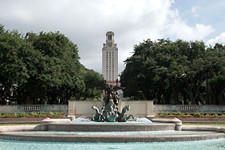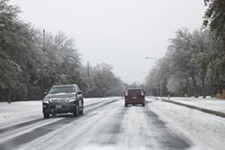As The Transportation Policy Turns, Latest Episode
The great Central Texas toll roads drama continues to unfold
By Kimberly Reeves, Fri., June 16, 2006
TxDOT District Engineer Bob Daigh asked the board this week to approve – at the very least – the engineering and right-of-way on the toll roads in the Phase II toll road plan so that federal approval won't be delayed. Because the roads would be tolled electronically, with no need for traditional tollbooths, the right-of-way and engineering would be identical, whether or not the roads are eventually tolled.
With so many questions still answered in the minds of board members, though, many were hesitant to move forward with the vote, which would have appropriated $448 million toward eight projects over the next three years. Of course, some of those members still face opponents at the polls in November, and even the hint of toll road support – especially if the impending toll road study comes back in the negative – could be used as a smear tactic in the upcoming campaign season. An alternatives study, spearheaded by Austin Council Member Brewster McCracken, is due back to a steering committee in August. As Rep. Mark Strama noted, how the projects examined in the study are prioritized and built could change, given whether they are tolled or not tolled in the future.
In fact, Strama led most of the charge on the toll road discussion Monday night. His point was that if toll bonds make up so little of the total toll road budget – only 15% in the case of toll roads with frontage roads – then that would appear to express the bond market's lack of faith in the viability of local toll roads. The Central Texas Regional Mobility Authority has argued that the percentage of bonding will vary by project, especially if road projects have free alternative lanes. Toll roads that expand current roadways will have less bonding; new roads that give new access to an area will have higher bonding potential. For now, and before any votes come up, Strama wants answers to three questions: •How much would the gas tax have to increase to raise the same amount of revenue the CTRMA projects would be raised from tolls in the Phase II plan? •How much does the cost of closing the gap in the Texas Metropolitan Mobility Plan increase – the current funding shortfall is $10 billion – if the region chooses not to toll the roads in the Phase II toll plan? And, finally, •How much revenue beyond what's needed for debt service is projected from the toll revenues, and where do those revenues go?
If the study comes back saying that nontolled makes more sense on some roads, then it could lead to an interesting game of chicken between local and elected officials. Austin has the biggest piece of the pie when it comes to the Texas Mobility Fund. But the Texas Transportation Commission has promised to take that away if those funds aren't used in the most efficient way possible, which is, by their definition, toll roads. Stay tuned.
Got something to say on the subject? Send a letter to the editor.








